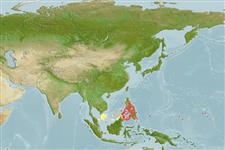Elasmobranchii (sharks and rays) >
Carcharhiniformes (Ground sharks) >
Triakidae (Houndsharks) > Galeorhininae
Etymology: Hemitriakis: Greek, hemi = half + Greek, triakis = three times (Ref. 45335). More on author: Herre.
Environment / Climate / Range
Ecology
Marine; demersal; depth range ? - 48 m (Ref. 244). Tropical, preferred ?; 20°N - 5°N
Western Central Pacific: known only from the Philippines.
Size / Weight / Age
Maturity: Lm ? range ? - ? cm
Max length : 96.0 cm TL (female)
An little-known inshore tropical shark found in coastal waters (Ref. 13563). Ovoviviparous (Ref. 50449).
Life cycle and mating behavior
Maturity | Reproduction | Spawning | Eggs | Fecundity | Larvae
Ovoviviparous, embryos feed solely on yolk (Ref. 50449). 12 young in a litter and size at birth at least 20 to 22 cm (Ref. 244).
Compagno, L.J.V., 1984. FAO Species Catalogue. Vol. 4. Sharks of the world. An annotated and illustrated catalogue of shark species known to date. Part 2 - Carcharhiniformes. FAO Fish. Synop. 125(4/2):251-655. Rome: FAO. (Ref. 244)
IUCN Red List Status (Ref. 115185)
CITES (Ref. 94142)
Not Evaluated
Human uses
Fisheries: subsistence fisheries
More information
ReferencesAquacultureAquaculture profileStrainsGeneticsAllele frequenciesHeritabilityDiseasesProcessingMass conversion
Tools
Special reports
Download XML
Internet sources
